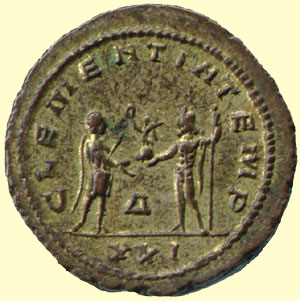 Contents -
Previous Article -
Next Article
Contents -
Previous Article -
Next Article
The Roman army was one of the finest fighting machines the world has ever known. Beginning as a group of citizen soldiers who provided their own arms and defended the early city of Rome in times of emergency, the Roman army grew to become one of the largest professional fighting forces the world had ever seen. In later years, the enormous bureaucracy that governed and supplied the Roman army would grow to rival those of modern days. During its 1,200 year existence in the West and 2,200 year history through Byzantine times, this army underwent numerous major transformations and smaller changes. Some changes were brought about by new advances in weapons, some because more effective tactics were developed, and some occurred because the pressing needs of the empire required change. One change that continued right up through the end was the increasing use of barbarian troops and officers. In the years before the end of the Roman Empire in the West, the army was composed of almost all barbarian troops who were defending an increasingly weak empire against their own relatives. If there was ever a conflict of interest, this surely would be one!
The legion was the largest unit in the Roman Army. Originally, a legion consisted of from 5000 to 5500 men, but seldom was a legion ever at its full strength. More often, a legion consisted of 4000 to 4800 combat ready troops.
Each legion was divided into cohorts of about 600 men each. Sometimes the number one cohort was twice the size of the others. The number one cohort was usually assigned to administrative and supply duties.
The basic battlefield unit was the century, originally composed of 100 men. This Latin word means a unit of one hundred and it is the same word we use today for a unit of one hundred years. Most legions had less than the full number of troops and usually contained between eighty and one hundred men, and sometimes even less than that. They were led by a non-commissioned officer called a centurion. There were different grades of centurions. Some were men who had only been in the army a few years and whose rank was roughly equivalent to a sergeant. Others were twenty year or more veterans and might be likened to a commissioned or staff officer in todayís United States or British army.
Another unit that appeared from time to time was the maniple. A maniple consisted of two centuries, giving a cohort of three maniples or six centuries.
During the Third Century, the emperor Gallienus introduced a fast, mobile striking force mounted on horseback. Before this time, Roman officers and soldiers sometimes rode horses to the scene of the battle but dismounted to fight. Gallienus? troops were real cavalry in that they fought from horseback as well.
Diocletian and Constantine officially divided the Roman army into the COMITATENSIS, or mobile fighting force, and the LIMITANEI or troops assigned to guard the frontier. This pattern was kept and maintained until the end of the Western Roman Empire. The idea behind the COMITATENSIS was to have a highly mobile field army that could be ready to go anywhere in the empire at a momentís notice and be on the scene of trouble in two to three weeks.
Auxiliary units began to be used more and more from the reign Of Septimius Severus in the early Third Century onward. These included lightly armed cavalry "wings", units of mounted archers (SAGITTARII), lancers, heavily armored cavalry (CATAPHRACTII), and other specialized units. Julius Caesar used skilled slingers from the Balearic Islands and Batavii (from near modern Belgium) who were strong swimmers and could withstand cold water. They made excellent special agents and infiltrators. Roman army organization, tactics, and strategy is the subject of countless books. The Roman Army still holds the fascination of military historians today, as more books are being written all the time as they have for over two thousand years.
Go to next article:
Go back to previous article: